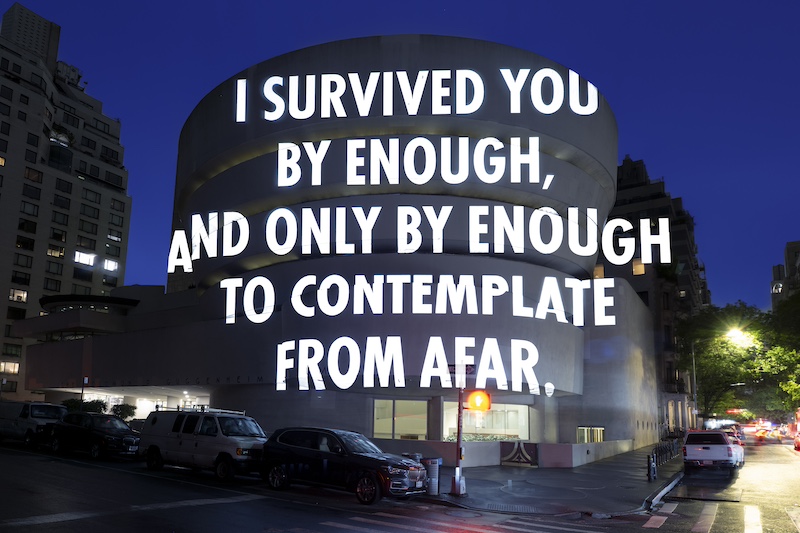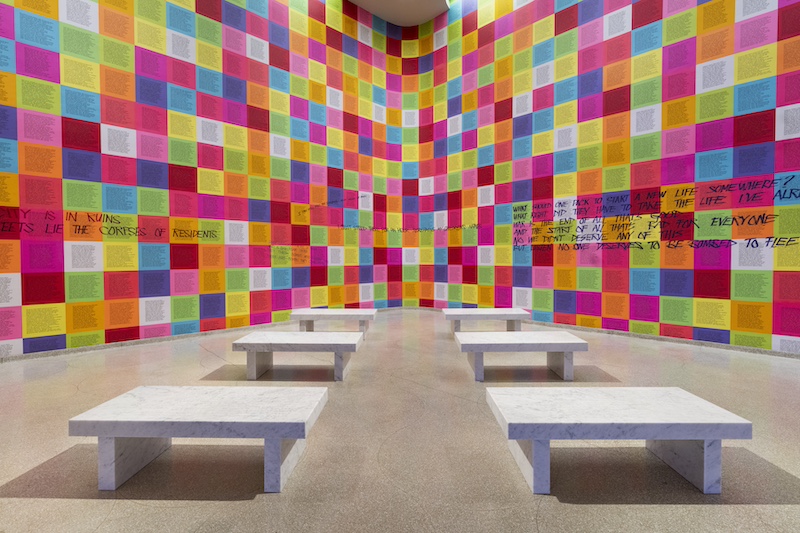Jenny Holzer’s Show At Guggenheim Revisits The Longest LED Sign From 1989
Jenny Holzer: Light Line at the Guggenheim Museum, New York which closes on Sept 29 is a timely reminder of how words impact us in a visual world.
- 27 Sep '24
- 12:02 pm by Manisha AR
In a world where people are inundated with visual images, taking the time to engage with text-based art can feel refreshing or exhausting—depending on the state of your attention span. On display at the Guggenheim Museum in New York since May of this year, the conceptual artists’ show ‘Jenny Holzer: Light Line’ takes viewers back in time while keeping their politics firmly grounded in the present. Nearly thirty-five years ago, American artist, Holzer created the same spiralling LED display at the Guggenheim which changed colours, fonts and all of the special effects texts 35 years ago could muster. It was the longest LED sign of its time. This historic and iconic work has been resurrected, and a team of the museum’s conservationists reverse-engineered the installation setup from 1989. The updated piece also incorporates artificial intelligence to create the graphics behind the scrolling text, commenting on changing technologies in the process while simultaneously contributing to scholarship on preserving technology-based works.

‘Light projection by Jenny Holzer at the Solomon R. Guggenheim Museum, New York, (Image credits: 2024 Jenny Holzer, Artists Rights Society (ARS), New York. Photographer: Filip Wolak)
In a time of divided political views, Holzer’s truisms ring louder than images can lately. Her installation sheds light on the responsibilities that come with being in positions of power– whether as governments or individuals. ‘Words Tend To Be Inadequate,’ ‘Much Was Decided Before You Were Born’ and ‘Mostly You Should Mind Your Own Business’ are a few examples of the text that flashes at patrons walking through the museum. Using the entire building as her pedestal and canvas, Holzer’s LED texts span all six ramps within the museum. They also exist in unexpected locations like outdoor planters, and the restrooms and even at some point they were projected on the museum’s exterior facade— much like the pressing issues of our time, they are everywhere, visitors just need to look.
Also read: Alchemies, A Journey Through Bharti Kher’s Most Ambitious UK Exhibition

Installation view of Jenny Holzer: Light Line by Jenny Holzer at Solomon R. Guggenheim Museum, New York. (Image credits: 2024 Jenny Holzer, Artists Rights Society (ARS), New York. Photographer: Ariel Ione Williams and David Heald, Solomon R. Guggenheim Foundation, New York)
A conceptual artist whose work uses a combination of original and borrowed text, Holzer’s works have mostly expanded in scale since she first began making work. She initially worked with paintings as her medium during her studies at Ohio University and Rhode Island School of Design. During her time a the Whitney Museum of American Art’s Independent Study Program, she engaged deeper in cultural theory and created some of her seminal work like the series called ‘Truisms series’ (1977-1979) followed by the ‘Inflammatory Essay.’ Soon after she began inscribing excerpts of these texts onto stone benches, sarcophagi, and floor tiles. She continued to produce text-based work that ranged from introspective to more public responses to events around the world.

In 1996, she began to work with light projects in public spaces that demanded attention. The text had also been reshaped and now borrowed from bureaucratic documents. In more recent years, one of Holzer’s famous messages: “ABUSE OF POWER COMES AS NO SURPRISE,” was readopted as a protest mantra in the #MeToo era. In working with textures, surface, visibility and the intricacies of calligraphy like writing in all-caps, and using serifs she tactfully turns her phrases into monumental proclamations that have echoed across generations. From creating works that responded to mass shootings in the United States- ‘It Is Guns’ (2018-2019) to the government’s mishandling of the COVID-19 pandemic – ‘Expose’ (2020), Holzer has steadfastly worked to bring renewed attention to pressing concerns, abuse of power and social inequality by building simple texts with clear takeaways. Yet each phrase holds a profound meeting that provokes introspection.

Jenny Holzer installing her exhibition in December 1989 at Solomon R. Guggenheim Museum, New York. (Image credits: Michele Perel, Solomon R. Guggenheim Foundation, New York)
Stemming from the 70s– an era of protests and powerful political changes that were often a direct result of protest, slogans and sheer collectivism of citizens– the impact of these text-based works remains influential. In addition to the iconic installation, the museum also includes a selection of Holzer’s work from the 1970s till the present day like paintings, plaques, works on paper and stone pieces she once released incognito alongside works on paper. The exhibition stands both in the past and present, pushing audiences to consider the future. Lee Quiñones, an artist, actor and a long-time collaborator of the artist, has graffitied the walls of the museum’s High Gallery. His work overalls Holzer’s ‘Inflammatory Essay’ (1979-1982) posters. The show invites viewers to experience the extraordinary power of rhetorical questions and their ability to provoke discourse around a divided political landscape. It’s also a good reminder that words still have the power to catalyse change.
For those who can’t be in Guggenheim before the show closes on September 29, 2024, the museum website has a wonderful audio series that feels like an auditory tour of the works on display. www.guggenheim.org





















